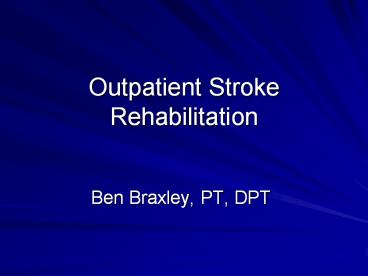Outpatient Stroke Rehabilitation - PowerPoint PPT Presentation
1 / 24
Title:
Outpatient Stroke Rehabilitation
Description:
Day hospital care is a subset of outpatient rehabilitation in which the patient spends a major part of the day in an outpatient rehabilitation facility. ~Agency ... – PowerPoint PPT presentation
Number of Views:1579
Avg rating:3.0/5.0
Title: Outpatient Stroke Rehabilitation
1
Outpatient Stroke Rehabilitation
- Ben Braxley, PT, DPT
2
OSR roadmap
- General definitions
- Components of Care
- Patient Needs
- Therapeutic Goals
- Methods
- A possible paradigm
3
Google Anecdote
- Outpatient Cardiac Rehabilitation
- 866,000 hits
- Outpatient Stroke Rehabilitation
- Did you mean inpatient stroke rehabilitation
- 151,000 hits
- Inpatient Stroke Rehab
- 122,000 hits
4
Outpatient Rehabilitation
- rehabilitation performed in an outpatient
facility that is either freestanding or attached
to an acute care or rehabilitation hospital. Day
hospital care is a subset of outpatient
rehabilitation in which the patient spends a
major part of the day in an outpatient
rehabilitation facility. - Agency for Health Care Policy and Research
5
Stroke Rehabilitation
- Assessment of the effect of stroke care
organization and settings is difficult because of
the extreme variability of organizational
settings. - Management of Adult Stroke Rehabilitation Care
A Clinical Practice Guideline
6
Outpatient Stroke Rehabilitation is a moving
target.
- Current descriptions include lists of goals and
possible components but rarely reflect the scope
or variability of the field.
7
Stroke Rehabilitation
- Components typically identified include
- A multidisciplinary team
- Variable time course
- Variable settings
- Variable outcome
- Most often characterized as a constellation of
services, each provided on an as needed basis
given a particular clinical presentation
8
Who are the patients?
- At 795,000 strokes per year
- With an estimated survivorship of 85
- Of which only 10 recover completely
- OSR candidates include an estimated 608,000
Americans per year with stroke related deficits - Of total stroke incidence between 80 and 87 are
Ischemic, the remainder being Hemorrhagic.
9
Referral and Utilization of OSR services
- Acute care physicians, neurologists, and
frequently physiatrists (following a period of
inpatient rehabilitation) - Approximately 31 of stroke survivors eventually
participate in OSR - Suggests 246,000 new OSR participants each year
at current rate
10
What are the treatment goals?
- To prevent complications
- Second stroke, DVT, pneumonia
- To minimize impairments
- Balance, endurance, cognition, and safety
- To maximize function
- Societal role, return to independence with
mobility, self-care, and driving
11
NSA controllable risk factors for secondary
prevention
- Hypertension reduction
- Atrial Fibrilation control
- Cholesterol management
- Diabetes management
- Smoking cessation
- Weight management
- Alcohol moderation
12
Why are they referred to OSR?
- Location of damaged tissue dictates deficits and
impairments - Language centers
- Motor control
- Motor planning
- Emotional centers
- Visual processing
- Memory
- Balance centers
13
From Stroke to Rehabilitation
- Post-stroke rehabilitation begins in the
inpatient setting, generally within 24-48 after a
stroke, as soon as medical stability is achieved. - Factors affecting the next level of care
- Stroke related deficits
- Insurance coverage
- Personal Budget
- And available rehabilitation options
14
Divergence from the OCR model
- OSR may appear as early as Phase 2 or as late
as Phase 5 for some stroke survivors. - Survivors with variable degrees of impairment
respond variably to rehabilitation setting, thus
complicating the decision matrix.
15
What does OSR entail?
- Patients typically spend several hours, often 3
days each week, at a facility taking part in
coordinated therapy sessions and return home at
night. - Team members may include Physicians, Nurses,
Physical Therapists, Occupational Therapists,
Speech and Language Pathologists, Recreational
Therapists, Kinesiotherapists, and
Neuropsychiatrists.
16
Methods
- Physical Therapy
- Gross motor and sensory skills acquisition and
maintenance - Strength
- Endurance
- Gait
- Balance
- Typically involves goal oriented behavior and
shaping to accomplish a desired mobility task.
17
Methods
- Occupational Therapy
- Fine motor and sensory skill acquisition and
maintenance - Grooming
- Hygiene
- Activities of Daily Living (ADLs)
- Compensatory strategies/Adaptive techniques
- Typically involves repeated practice of daily
routines with increased emphasis on problem
solving and facilitatory techniques.
18
Methods
- Speech-Language Therapy
- Cognitive and Oromotor rehabilitation
- Aphasia
- Swallow Therapy
- Problem Solving
- Coping
- Typically involves individualized
critical-thinking and/or oromotor practice
sessions
19
Methods
- Recreational Therapy
- Return to leisure activities with emphasis on
practicing impaired tasks - Kinesiotherapy
- Movement and exercise therapy directly prescribed
by a physician
20
Other aspects of OSR
- Within the past decades many believed that all
post-stroke recovery was spontaneous and natural. - Eventually greater intensity specialized care
was shown to be associated with improved
post-stroke outcome. - Unfortunately, the mechanisms remain unclear and
techniques remain variable.
21
Pathways versus Guidelines
- An extensive literature review has shown that to
date Care Pathways do not improve outcomes or
reduce costs. - However, compliance with stroke rehabilitation
guidelines does improve outcome. - ?Structured individualization within a specific
set of circumstances seems to reflect current
best practice.
22
Pathways
- Pathways seek to prescribe a set of interventions
to a population with a certain qualifying
condition. - Again, a problem of scale. Writ large pathways
seem a hindrance. - Fine tuning pathways to specific stroke locations
may eventually demonstrate improvements in
outcome.
23
An Emerging ParadigmElements of the perfect
storm
- Coordinated multidisciplinary staff
- Regularly scheduled meetings
- Routine involvement of carers
- Staff specialization
- Standardized and early assessments
- Better diagnostic procedures
- Early mobilization
- Prevention of complications
- Better application of best practice
- Attention to Secondary Prevention
24
Barriers to OSR
- Transportation issues
- Environmental constraints
- Depression
- Fatigue
- Financial constraints































